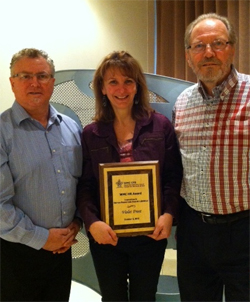Thinking Safety Nets HR Innovation Award
By Laurie Glasser, CHRP
Violet Frost, CHRP, was recently honoured with the prestigious 2012 “Innovation in Human Resources Award” for her outstanding contributions at Westwood Fine Cabinetry. Presented by the Wood Manufacturing Council (WMC), Violet’s award recognized the exceptional improvements achieved in the company’s Occupational Health and Safety Program.

Stephen Kennedy and Robert Porter, project managers at the Wood Manufacturing Council present Violet Frost with her award.
What was the catalyst that led you to seek improvements in your company’s Occupational Health and Safety Program?
Westwood was experiencing a challenge to its WorkSafeBC (WSBC) claims history with above average experience ratings, which resulted in surcharges to its assessable payroll. Employees were experiencing injuries at work and rehabilitation occurred off work until employees were able to fully return to their regular job.
In order to identify the root problems and potential solutions, what steps did you take?
HR had historically not been involved with Westwood’s Occupational Health & Safety (OHS) Program. Once HR became involved, an improved safety climate occurred which resulted in a reduced WSBC claims history by the implementation of best HR and health and safety practices, ideas and solutions to improve the WSBC claims cost record.
Eventually the OHS program became involved with employee wellness by partnering with the Canadian Cancer Society to promote their many wellness modules (which saw improvements in healthy eating, physical activity, tobacco cessation and sun awareness). Eventually Westwood’s program name changed to the Occupational Health, Safety & Wellness Program.
Did you involve other external organizations?
Yes, we initially developed professional working relationships with staff at WorkSafeBC and the Employers’ Advisers Office to target improvements in health and safety. Then Westwood became involved with the pilot project at the Canadian Cancer Society to implement wellness modules.
Could you describe the most significant factors or changes that contributed to the great success you achieved?
We developed effective incident investigation programs and ensured thorough follow up; Created regular and ongoing training & education of supervisors, lead hands and employees; Developed our first Employee Handbook, which extensively detailed Westwood’s health and safety rules; Implemented an effective claims management program which includes effective return to work programs that allows employees to return to work in a suitably timely manner based on their recover; Successfully negotiated and appealed relief of costs, which resulted in substantial credits that otherwise would have been costs against Westwood’s claims history; and Successfully took claims to both WSBC appeal and Workers’ Compensation Appeal Tribunal, resulting in positive rulings for Westwood.
These improvements resulted in a positive claims cost record for Westwood. Comparing 2010 to 2012, the claims cost record was improved by over 600 per cent. Westwood has gone from claims cost of:
- 2010 – average 119 employees at $56,700
- (As of July 2012) – average 97 employees at $4,600
What does the successful outcome and this award mean to you?
Being a fiscally driven HR professional, seeing these types of financial improvements is of great satisfaction. However, from the most important perspective – employee safety – these improvements have meant that our employees are now working in a safer environment and they are less likely than ever before to be hurt at work. Adding the wellness component further enhanced the work environment at Westwood Fine Cabinetry.
Were there any difficulties to overcome along the way? What did you learn from them?
There was resistance in taking employees off the floor for training and education, since this stops production and impacts profit. There was considerable dialogue with executive management regarding the necessity of training and education; eventually that resistance was partially overcome. Instead of in-person training and education in a workshop format, information was communicated via posting on the bulletin boards, on-site supervisor/employee conversations occurred with the improved safety climate being the result. I learned that there are many different ways of overcoming difficulties, and training and education could be delivered via other methods.
Do you have any advice you can share for organizations wanting to provide a safe work environment for their staff?
There are outstanding and dedicated professionals at both WorkSafeBC and the Employers’ Advisers Office who are willing to share their knowledge to improve organization’s safe work environment. There are many high quality educational programs offered through these organizations that are free and available in the community. As well, the wellness modules from the Canadian Cancer Society where a welcome addition to the work environment.
HR professionals should offer to be part of their organization’s Occupational Health & Safety since they are often seen as a change agent in their organization & any change to positively improve health & safety is a step in the right direction.
Laurie Glasser, CHRP, is the owner of Kelowna Human Resources Consulting. She is a member of BC HRMA’s Southern Interior Advisory Council and manages the awards and communication portfolios.







